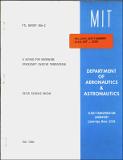A method for governing spacecraft evasive maneuvering
Author(s)
Keller, Keith Richard
DownloadFTL_R_1986_02.pdf (11.13Mb)
Other Contributors
Massachusetts Institute of Technology. Flight Transportation Laboratory
Metadata
Show full item recordAbstract
A computer program is developed to govern the evasive maneuvering of a spacecraft in response to an anti-spacecraft missile threat in regions of space where drag is not significant. With a view to circumventing the need to numerically integrate the equations of motion for both vehicles to predict future position and velocity along their trajectories, the methods of astrodynamics are used to determine the unissile's orbit from two vector position fixes over time so it can be compared -to the spacecraft's orbit, determined from a position and velocity vector. The transfer time required for the missile to reach the spacecraft's altitude is determined and the future position of the missile is predicted so that a future relative position vector between the spacecraft and missile can be found. If it is found that the missile will intercept the spacecraft at the future time, appropriate evasive action is initiated for the spacecraft. A maneuver to any point in three-dimensional space can be targeted by specifying the magnitude and direction of the miss-distance desired, and velocityto- be-gained calculations are done as an aid to making maneuvering decisions. To test the assumptions of the astrodynamic techniques in the program, a fourth-order Runga-Kutta numerical integration technique was implemented in the program and is used to update all current trajectory data points. Spacecraft engine thrust, if an impulsive maneuver is not selected, atmospheric drag, and higher order gravitational harmonics are modelled and included in the integration of the equations of motion for both vehicles. When the trajectories of the vehicles were fully integrated to the predicted intercept time, the integrated data points could then be compared to those generated through the astrodynamic techniques. It was found that agreement between integrated and astrodynamic data points could typically be obtained to the third or fourth decimal place in kilometers in scenarios where drag was not significant. The astrodynamic techniques were found to be able to predict intercept and provide information for maneuvering the spacecraft in real-time for simulations run on a VAX 11/750, while the integration techniques experienced a time lag in updating trajectories which was dependent on the integration step size used.
Description
May 1986 Also issued as an M.S. thesis, Massachusetts Institute of Technology. Dept. of Aeronautics and Astronautics, 1986 Includes bibliographical references (p. 249-251)
Date issued
1986Publisher
Cambridge, Mass. : MIT, Dept. of Aeronautics & Astronautics, Flight Transportation Laboratory, [1986]
Other identifiers
16386567
Series/Report no.
FTL report (Massachusetts Institute of Technology. Flight Transportation Laboratory) ; R86-2
Keywords
Navigation (Astronautics), Space vehicles, Control systems, Computer programs